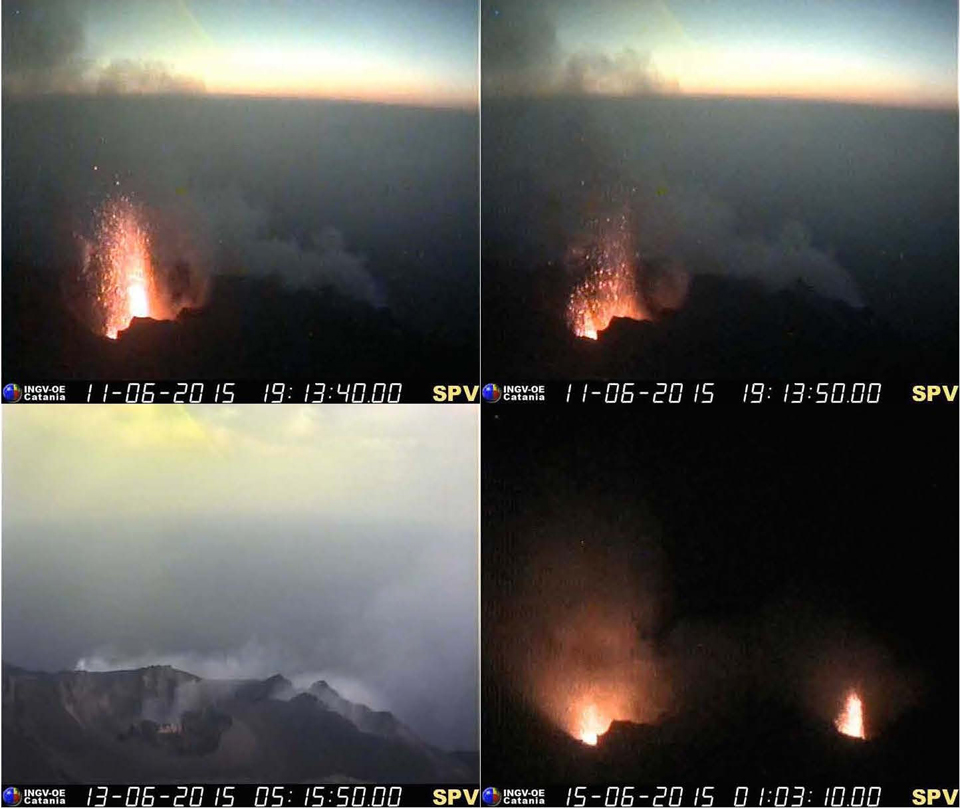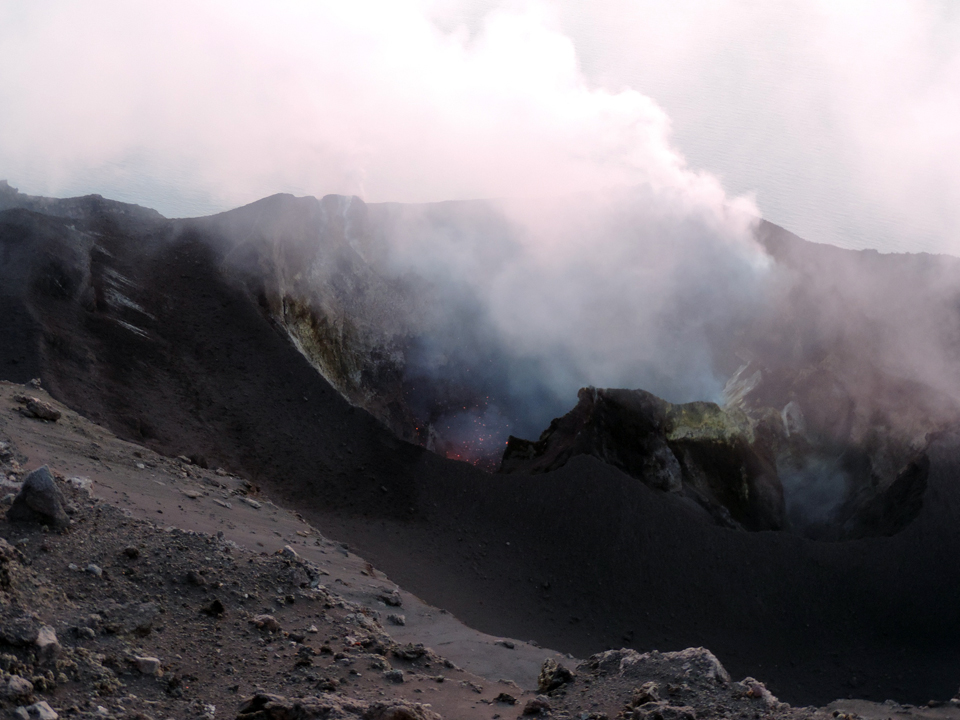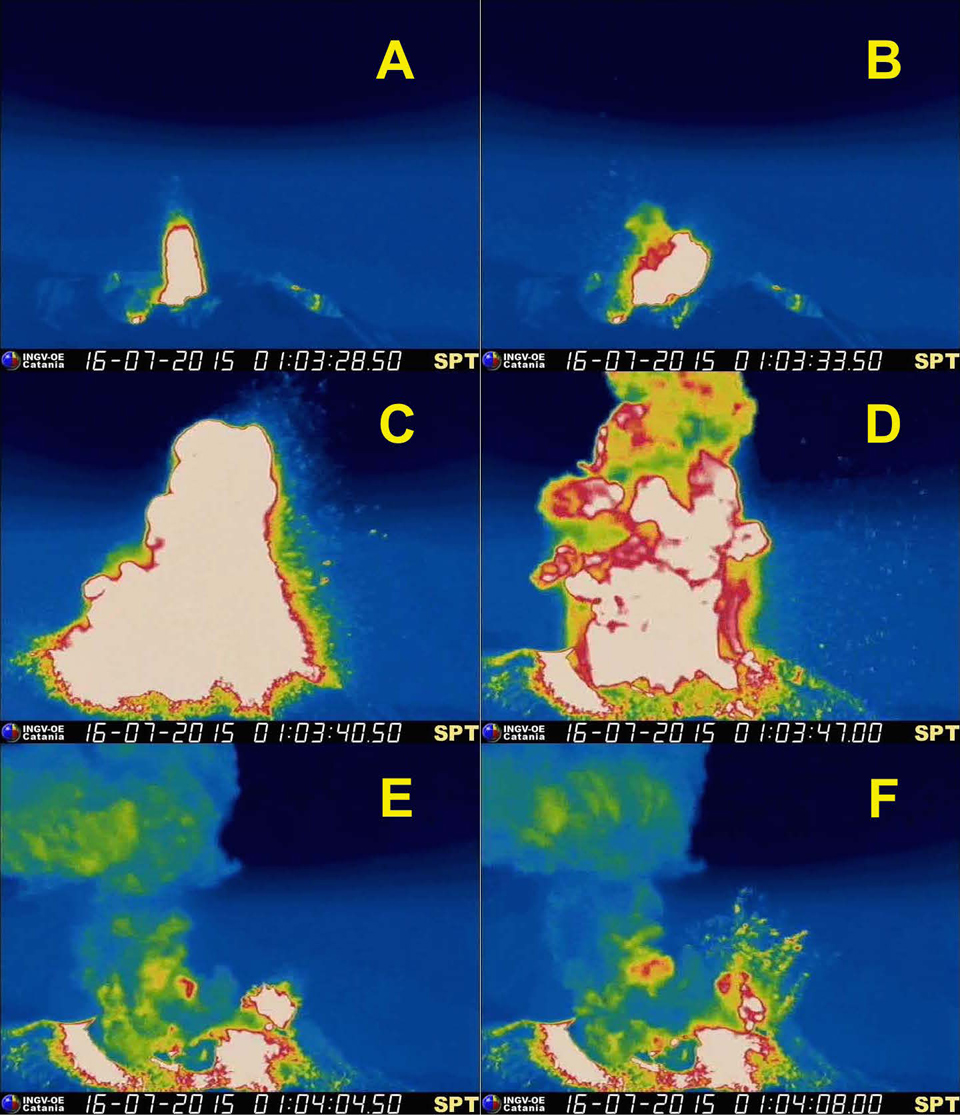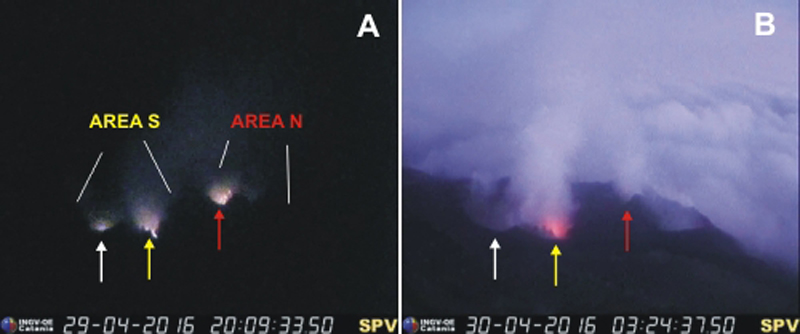Report on Stromboli (Italy) — July 2017
Bulletin of the Global Volcanism Network, vol. 42, no. 7 (July 2017)
Managing Editor: Edward Venzke.
Edited by A. Elizabeth Crafford.
Stromboli (Italy) Persistent low- and moderate-level explosive activity during 2015 and 2016
Please cite this report as:
Global Volcanism Program, 2017. Report on Stromboli (Italy) (Crafford, A.E., and Venzke, E., eds.). Bulletin of the Global Volcanism Network, 42:7. Smithsonian Institution. https://doi.org/10.5479/si.GVP.BGVN201707-211040
Stromboli
Italy
38.789°N, 15.213°E; summit elev. 924 m
All times are local (unless otherwise noted)
Confirmed historical eruptions at Italy's Stromboli volcano go back 2,000 years as this island volcano in the Tyrrhenian Sea has been a natural beacon for eons with its near-constant fountains of lava. Explosive activity during 2014 generated numerous lava flows that traveled down the flanks, including several that reached the ocean during August (BGVN 42:01). The volcano was quieter during 2015 and 2016 as reported by the Instituto Nazionale de Geofisica e Vulcanologia (INGV), Sezione de Catania, who monitors the gas geochemistry, deformation, and seismology, as well as the surficial activity at Stromboli. Their weekly reports are summarized briefly below. Eruptive activity at the summit consistently occurs from multiple vents at both a north crater area (N Area) and a southern crater group (S Area) on the Terrazza Craterica at the head of the Sciara del Fuoco, a large scarp that runs from the summit down the NW side of the island. Thermal and visual cameras placed on the nearby Pizzo Sopra La Fossa monitor activity at the Terrazza Craterica.
No reports were issued by INGV after a report of 16 October 2014. The last activity at Stromboli in 2014 captured remotely was a MODVOLC thermal alert on 8 November 2014. Low- to medium-intensity explosions from the active vent areas at the summit characterized activity throughout 2015 and 2016. Occasional bursts of higher-intensity activity sent ash, lapilli, and bombs across the Terrazza Craterica and onto the head of the Sciara del Fuoco.
Activity during 2015. While no thermal anomalies were identified in MODIS data during 2015 or 2016, the eruptive activity continued at low-to-moderate levels. Strombolian explosions were frequent from both crater areas during January 2015. Six explosions accompanied by abundant ash emissions erupted from the N Area on 12 and 13 January. In the S Area, vents also produced tephra containing lapilli and small bombs. A high-intensity burst from the S Area on 23 January contained ash and a few lapilli and bombs.
Intermittent explosive activity continued at both crater areas during February 2015. Medium-to-low intensity explosive activity during the first week characterized the N Area, with the ejection of bombs mixed with ash. Strombolian activity increased on 7 February. In the S Area, explosions were characterized by the ejection of fine ash with lesser coarse material (lapilli and bombs). An energetic explosive event took place at the S Area on 15 February (figure 92). It was the strongest event since the activity of August 2014, and was followed by several explosions over the following 12 hours that contained abundant tephra.
Low-intensity explosions characterized both the N and S Areas during March and early April 2015. Beginning on the afternoon of 15 April, the intensity and number of explosions increased significantly in the N Area for about 48 hours. Low- to medium-intensity explosions continued at both crater areas during May. On the evening of 11 May, and again during 13-15 May, a continuous glow was observed from the S Area caused by significant spattering activity. Strombolian activity was also noted from both crater areas on 20 and 21 May, and was more frequently observed during June 2015 (figure 93).
Members of an expedition to the summit on 1 July 2015 observed explosive activity from the S Area vents (figure 94). Activity continued at low-to-moderate levels during July. On 16 July, a strongly intense explosive sequence occurred at both crater areas (figure 95). The first explosion occurred in the S Area at 0103. A larger explosion a few seconds later produced a jet of bombs and lapilli that lasted for about 15 seconds and rose about 300 m into the air, depositing material across the Terrazza Craterica area and the upper part of the Sciara del Fuoco. A third explosion, this time from the N Area, occurred about one minute later, ejecting bombs and lapilli 200 m into the air. Intense spattering continued from both crater areas for the next hour, after which activity resumed at lower levels.
Low-intensity explosions accompanied by weak and discontinuous spattering with ash, lapilli, and bombs characterized activity from both areas for most of August except for a short-lived (2-hour) vigorous explosive event at the S Area beginning around 2300 on 8 August 2015. Activity was more vigorous at the N Area from 23 August through the end of the month. Low- and medium-low intensity explosions were typical during September with only a few days of medium- to medium-high intensity explosive events. Activity during October was difficult for INGV to monitor due to difficulty with their equipment, but it appeared to continue at low-to-moderate levels.
A series of medium- and medium-high intensity events occurred during 7-9 November 2015 from the N Area and were captured by the thermal camera on the Pizzo Sopra La Fossa (figure 96). Two vents in the N Area produced strong explosions at the same time generating plumes with fine ash and lapilli that likely reached over 200 m above the Terrazza Craterica. Another strong explosion from the N Area occurred on 19 November, sending coarse ejecta onto the top of the Sciara del Fuoco.
Explosions during 12 and 14 December ejected bombs and lapilli onto the Sciara del Fuoco. During an overflight on 16 December thermal imagery showed hot explosive material from the N Area deposited on the Sciara del Fuoco, and freshly erupted material surrounding the S Area as well.
Activity during 2016. During January 2016 windy and cloudy weather conditions and technical equipment problems made observations difficult for INGV, but activity was generally low to moderate at both crater areas. A strong Strombolian explosion from the N Area on 14 January was one of the larger events of the month, sending lapilli and bombs to the top of the Sciara del Fuoco. Numerous explosions from the N Area of medium-to-medium-high intensity were typical during February. Explosions at the S Area were generally low intensity. Clear weather on 15 February provided an excellent view of the two crater areas on the Terrazza Craterica (figure 97). A brief event on 21 February at the S Area caused weak spattering around the vent.
During March 2016, two vents were active in the S Area, and one in the N Area until 16 March, when a second vent began activity (figure 98). The typical frequency of events during low-level activity is 0-1 explosions per hour. Rarely, higher energy events will deposit material on the Sciara del Fuoco. After a month of low-intensity activity at both crater areas, there was a rapid intensification of explosive activity at the S Area at around 2130 on 28 April, which continued through 1 May (figure 99).
Generally low-level activity during most of May was interrupted during 6-11 May with persistent incandescence and pulsating spattering at the S Area vents. Occasional medium-to-high-intensity explosions from the S Area produced significant ash emissions during the second half of May, and often sent lapilli and bombs on to the Terrazza Craterica, and occasionally onto the Sciara del Fuoco.
Events with medium-to-high intensity levels continued at the S Area during June 2016, which resulted in ash emissions covering much of the Terrazza Craterica. Intensity increased in the N area by the third week of June. Two site inspections on 6 and 7 July by INGV provided details of the ongoing changes in morphology at the Terrazza Craterica (figure 100). At the N Area, they noted two distinct vents, while in the S area they observed a large crater depression with subvertical walls that had many deep vents on the S side. Episodic explosive activity from the N Area was accompanied by small ash plumes. In the S Area, landslides occurred along the southernmost wall, lasting for tens of seconds and producing small ash clouds.
During late July, persistent incandescence was visible at night from the Pizzo Sopra La Fossa coming from the northernmost vent of the S Area, which continued until 19 August. Activity diminished from this vent and appeared at the southernmost vent of the S Area on 20 August. Explosions of incandescent lava were observed about ten meters above the crater rim. Occasional high-intensity explosions from the N Area resulted in coarse ash emissions during August, especially during 27 and 28 August when two vents were active at the N area, sending bombs, lapilli, and ash onto the Sciara del Fuoco.
By the end of August activity was concentrated mostly in the N Area where two active vents ejected lapilli, bombs, and abundant ash in explosions that occurred at a rate of 2-3 per hour. On 29 September, a nighttime pulsating glow was observed from the Pizzo Sopra La Fossa visible camera emanating from the southernmost vent of the S area. Observations of the glow persisted until 6 October. INVG inferred the glow was related to deep explosive activity. Typical low-to-moderate activity during October included Strombolian activity several tens of meters above the crater rim and frequent ash emissions, primarily from the S Area.
During November and December 2016, low- and moderate-level activity continued, with persistent incandescence observed at northern vent of the S Area for most of December, and rare low-and-medium-intensity explosions observed at the N Area (figure 101).
Geological Summary. Spectacular incandescent nighttime explosions at Stromboli have long attracted visitors to the "Lighthouse of the Mediterranean" in the NE Aeolian Islands. This volcano has lent its name to the frequent mild explosive activity that has characterized its eruptions throughout much of historical time. The small island is the emergent summit of a volcano that grew in two main eruptive cycles, the last of which formed the western portion of the island. The Neostromboli eruptive period took place between about 13,000 and 5,000 years ago. The active summit vents are located at the head of the Sciara del Fuoco, a prominent scarp that formed about 5,000 years ago due to a series of slope failures which extends to below sea level. The modern volcano has been constructed within this scarp, which funnels pyroclastic ejecta and lava flows to the NW. Essentially continuous mild Strombolian explosions, sometimes accompanied by lava flows, have been recorded for more than a millennium.
Information Contacts: Istituto Nazionale di Geofisica e Vulcanologia (INGV), Sezione di Catania, Piazza Roma 2, 95123 Catania, Italy (URL: http://www.ct.ingv.it/en/).











